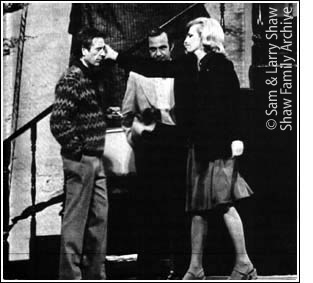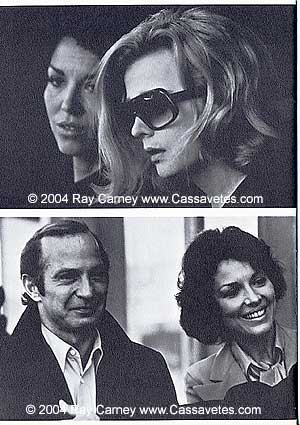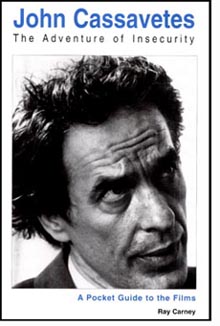|
 Cassavetes
was a deeply spiritual filmmaker. From Shadows to Love Streams
his theme is growth and renewal—which in his work, to some extent, always
involves personal upheaval and disruption. Growth is painful because it
asks us to leave old definitions of ourselves behind. In Cassavetes’ view,
throughout our lives we build emotional cocoons that shield us from truth.
The cocoon can be anything that lets us coast through experience: a job
we take our identity from, a comfortable economic status, a marriage—any
unexamined definition of who we are and what our lives mean. Security,
smugness, and complacency are the enemies of truth. Cassavetes
was a deeply spiritual filmmaker. From Shadows to Love Streams
his theme is growth and renewal—which in his work, to some extent, always
involves personal upheaval and disruption. Growth is painful because it
asks us to leave old definitions of ourselves behind. In Cassavetes’ view,
throughout our lives we build emotional cocoons that shield us from truth.
The cocoon can be anything that lets us coast through experience: a job
we take our identity from, a comfortable economic status, a marriage—any
unexamined definition of who we are and what our lives mean. Security,
smugness, and complacency are the enemies of truth.
The master narrative of all
of Cassavetes’ films is to force characters to shed their old skins. The
events and interactions are battering rams to splinter the emotional and
intellectual walls characters immure themselves within. As Shadows’
Lelia, Faces’ Maria Forst, A Woman Under the Influence’s
Mabel, Love Streams’ Sarah, and Opening Night’s Myrtle illustrate,
the discovery of who we really are can begin only when our routines are
disrupted. We must be forced out of our places of comfort. Breakdown is
the first step in breaking through to reality. In fact, one might say
that the breakdowns many of Cassavetes’ characters undergo (especially
the female characters) are evidence that there is still hope for them.
Not to break down, to  maintain your old routines at all costs,
to hold onto an established definition of yourself with a death grip—as
figures like Richard, Zelmo, Cosmo, and Robert do—is to be truly damned. maintain your old routines at all costs,
to hold onto an established definition of yourself with a death grip—as
figures like Richard, Zelmo, Cosmo, and Robert do—is to be truly damned.
Cassavetes’ screenplay describes
the main characters in Opening Night as "the most exciting,
dedicated members of the American theater." They are extremely talented
professionals. They are so good that, as the company director Manny Victor
puts it at one point, their scenes "bounce." Perhaps they are
too professional, too sophisticated, too good. Myrtle’s narrative function
(for them and for herself) is to desynchronize their rhythms, to interrupt
the "bounce," to create fights that won’t be played "by
the numbers" (as another line in the film has it). She throws a monkey
wrench into their well–oiled theatrical machine. There is a recurring
joke that punctuates various on–stage scenes involving how dealing with
a misplaced prop can either contribute energy to a scene or destroy it,
and Myrtle is a prop that won’t stay where you want it to be either on–stage
or off. The question the film asks is whether the result is creativity
or confusion.
Myrtle undergoes a mid–life
crisis in the course of the film (as do Manny Victor and his wife Dorothy—as
is sketched in a beautifully understated, brief late–night conversation
between them early in the movie). Her crisis is precipitated by a combination
of events. A long–term love affair with co–star, Maurice Adams, has recently
ended, causing her to doubt her sexual attractiveness. The death of Nancy
Stein, an adoring young fan, has reminded her of how much less alive her
emotions are than when she was younger. Her difficulty with her present
on–stage role has made her question her talent.
* * *
 Though
Myrtle is a star, Cassavetes is fundamentally opposed to the star–system
understanding of life. His work is fundamentally about relationships,
interactions, ensemble responsiveness. Circulation is the law of life
in all of Cassavetes’ work. No man or woman is an island, and no personal
understanding of an event remains unchallenged by other understandings
or is allowed to stand still. No filmmaker was more opposed to the notion
of letting one figure’s perspective and feelings control the narrative. Though
Myrtle is a star, Cassavetes is fundamentally opposed to the star–system
understanding of life. His work is fundamentally about relationships,
interactions, ensemble responsiveness. Circulation is the law of life
in all of Cassavetes’ work. No man or woman is an island, and no personal
understanding of an event remains unchallenged by other understandings
or is allowed to stand still. No filmmaker was more opposed to the notion
of letting one figure’s perspective and feelings control the narrative.
Cassavetes won’t let Myrtle
reign supreme as the uncontested star of his movie. At every point that
the viewer attempts to narrow his perspective and treat the film as Myrtle
Gordon’s drama, Cassavetes broadens it, forcing him to acknowledge a dozen
others on whom Myrtle depends or who depend on her—from the money men,
to the producer and director of the play, to a range of stage hands, grips,
and technicians. Cassavetes circulates the viewer through dozens of different
and contradictory personal perspectives. Myrtle may be undergoing an emotional
breakdown, but the viewer is never allowed to forget that to others in
the film, she is jeopardizing a financial investment. A shot of her in
crisis will include a view of an unrelated character thinking entirely
different thoughts in the background. A scene in which Myrtle tries to
make her own personal drama the center of attention will be intercut with
shots reminding us of the entirely different perspectives of stagehands
in the wings, other actors and technicians, on stage and off, and uncomprehending
members of the audience in the theater. Star though she may be in the
play, Myrtle is not given the luxury of starring in life or in this film.
The more single–minded she becomes, the more multiple–minded Cassavetes’
shooting and editing become.
This page only
contains excerpts and selected passages from Ray Carney's John Cassavetes:
The Adventure of Insecurity. To learn how to obtain the book, please
click
here.
|









